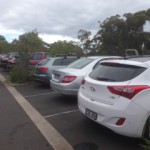DATA NEWS We love data!
Don’t discount a rural recovery
The gloom merchants were in full cry this week trying to be the first to call the end of the world as we know it, just as the sharemarket headed down toward a three-year low. So I thought I’d brighten things up by looking at the positives in the economy.
Some we know about, and some that seem to be overlooked.
First, we’re still spending. Anecdotally it looks like the retail figures will come in on the right side of the ledger post Christmas. Low interest rates and low petrol prices are putting more money in peoples pockets who are mostly sitting on capital gains in a now slowing housing market.
Secondly, despite what the gloom merchants say the job market seem to be holding steady.
And thirdly, although a lot of market pundits seemed to have missed it, there’s a reasonable revival happening in agriculture, which is putting a smile of the faces of a lot of farmers. A little more rain in 2016 will make them even happier.
So here are the numbers: Employment fell by 1000 in December, but after rising by 75,000 in November. Full-time jobs rose by 17,600 while part-time jobs fell by 18,500. Economists had tipped a 12,500 fall in jobs. Unemployment moved from 5.84 per cent to a 26-month low of 5.76 per cent. CommSec expects the unemployment rate will continue to drift lower over 2015 towards 5.5 per cent.
The job ad market is also showing some healthy signs which we all know is an early indicator.
And it seems that if we’re not at the Christmas sales it because we’ve been driving around in our new cars.
There were 98,639 new vehicles sold in November, up 6.9 per cent over the year. In the year to November 2015 a record 1,152,601 new vehicles were sold. I can remember when selling more that a million cars a year was basically just a salesman’s dream, but affordability and low fuel costs are renewing Australia’s carpark.
On the bigger picture, Australia’s trade deficit narrowed from $3.2 billion in October to $2.9 billion in November. Don’t get excited it was the 20th consecutive monthly deficit.
But the number that caught the eye was rural exports, which rose 15.3 per cent against the no-rural figure of minus 1.3 per cent. Services also improved slightly but the import figure from India was also a highlight as that country tries to catch up with China on the manufacturing front. If they can fix their infrastructure watch out.
That rural number was more than encouraging. The Australian Bureau of Agricultural and Resource Economics and Sciences (ABARES) forecasts in its December numbers were also pretty solid.
* “The gross value of farm production is forecast to increase by 8 per cent in 2015-16 to around $57.6 billion.
* The gross value of livestock production is forecast to increase by around 13 per cent in 2015-16 to $30.0 billion following an estimated increase of 16 per cent in 2014-15.
* The forecast increases in farmgate prices are expected to more than offset a forecast decline of 5 per cent in the volume index of livestock. This is as a result of herd and flock rebuilding.
* The gross value of crop production is forecast to increase by 2 per cent in 2015-16 to $27.6 billion alongside an expected increase of 2 per cent in the volume index of crop production. This represents the falling world prices of grains and oilseeds.
* Export earnings from farm commodities are forecast to be around $44.0 billion in 2015-16, following a rise of 6 per cent to an estimated $43.6 billion in 2014-15. At this level, export earnings from farm commodities in 2015-16 would be around 15 per cent higher than the average of $38.2 billion over the five years to 2014-15 in nominal terms.
“In Australian dollar terms, export prices of beef and veal, wool, wine, lamb, live feeder/slaughter cattle, rock lobster, mutton and chickpeas are forecast to increase in 2015-16. In contrast, export prices of wheat, barley, sugar and dairy products are forecast to decline.”
So what we’re seeing here is a collapse of sharemarket confidence, bought about by a number of global fears – economic slowdown, oil crisis, commodity crisis, and terrorism – while the domestic economy beavers away transitioning from a commodity-based economy to one based on consumption and services. But watch that rural sector riding high too.


